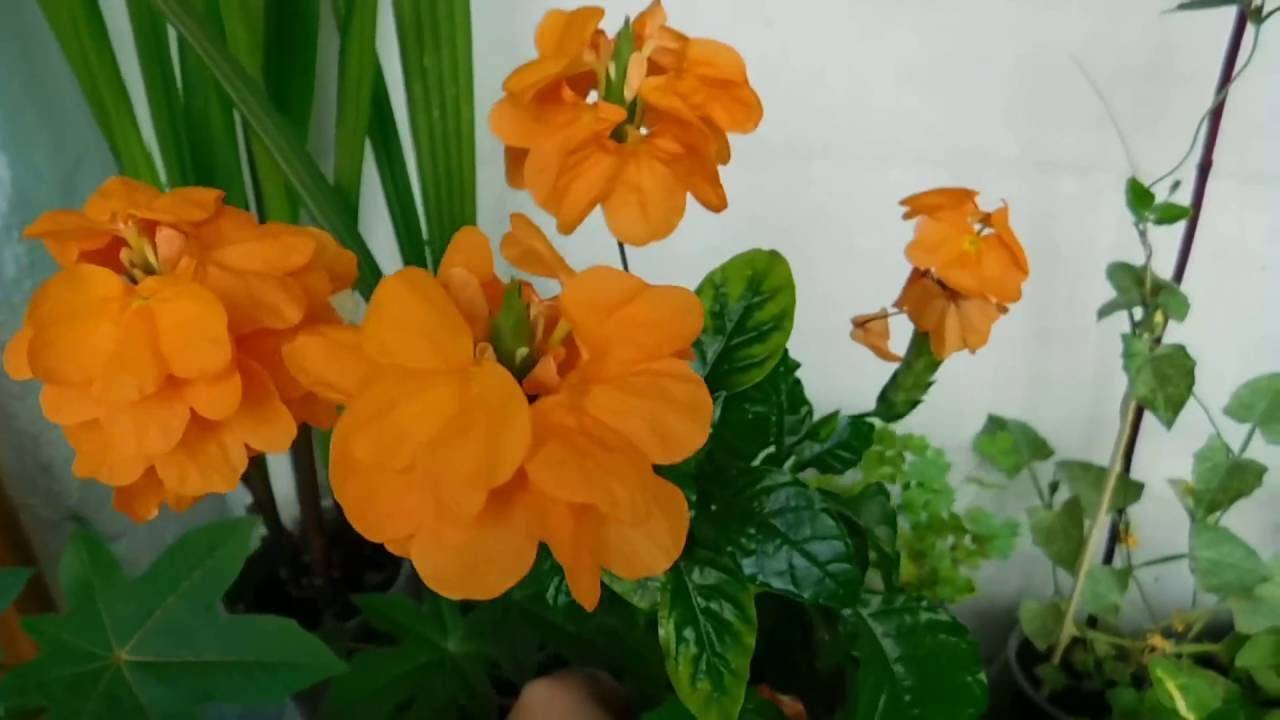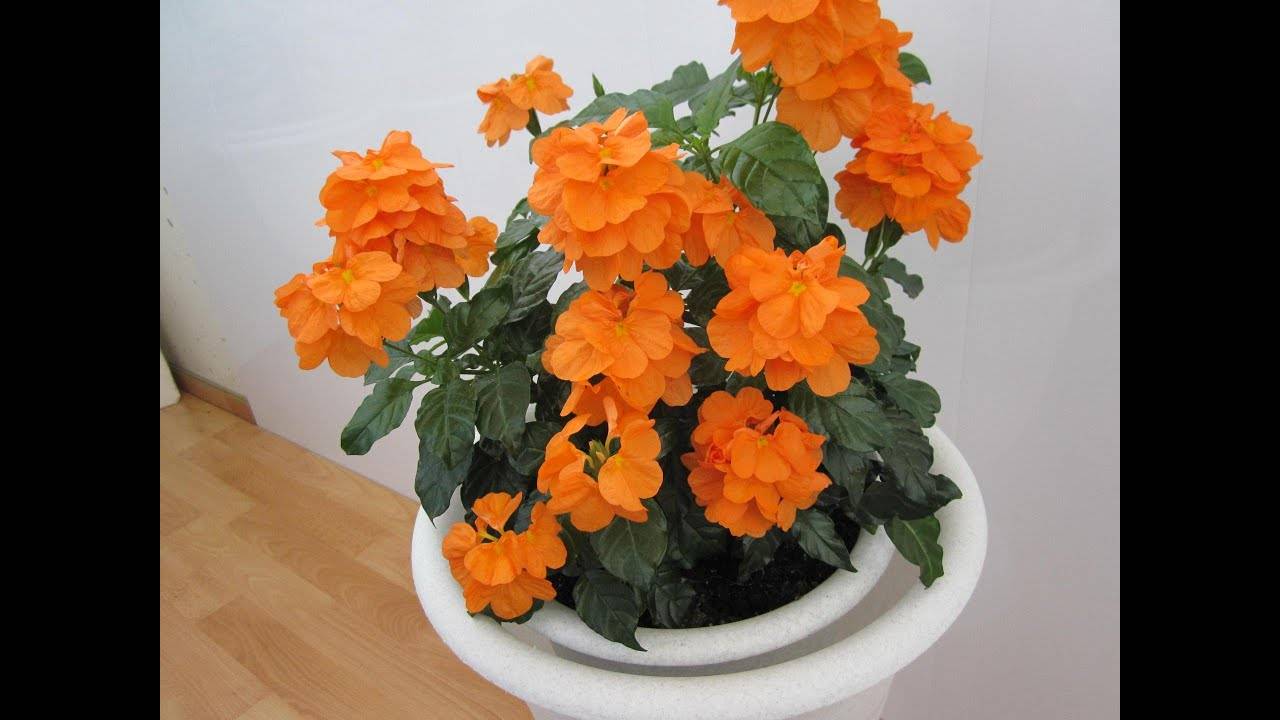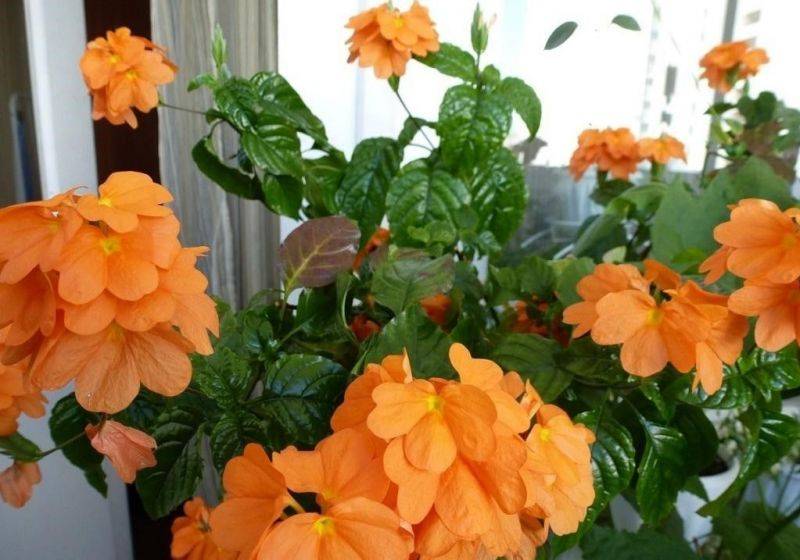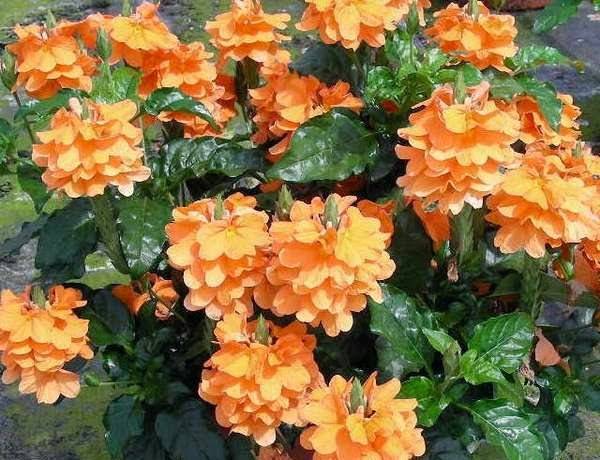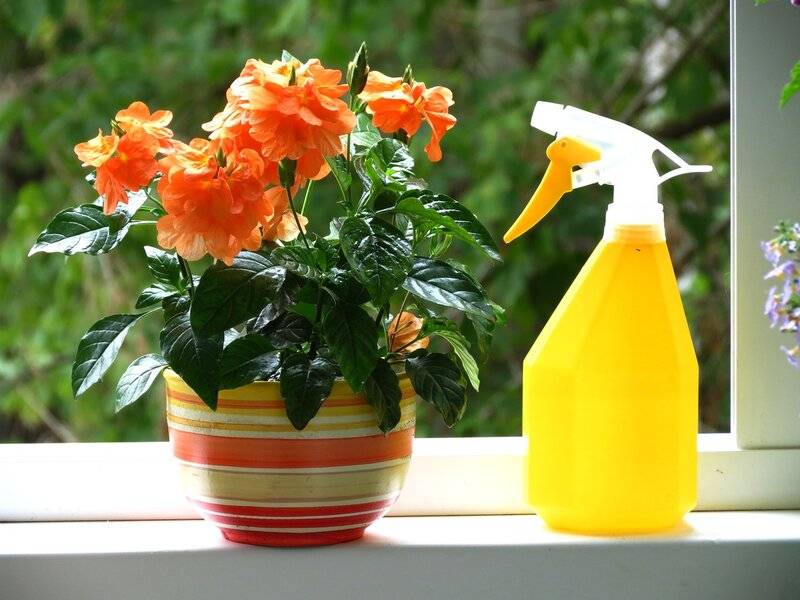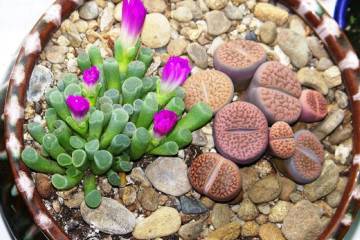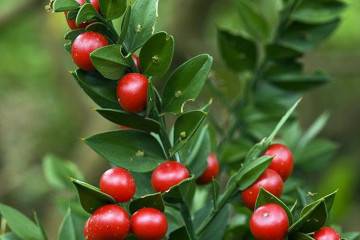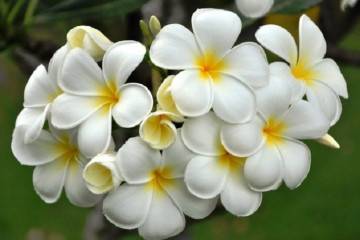Crossandra - home care
Content:
Crossandra belongs to the category of ornamental plants, which are members of the Acanthus family. The closest relatives of the culture are ruelia and pachistachis. Growing crossandra is not such an easy process. Mistakes made can cause not only the lack of flowering, but also the death of the decorative culture. The recommendations below regarding care must be strictly followed.
Description
Shrubs are called crossandra, which are distinguished by strong branching. The length of each bush can reach 45-50 cm. Under natural conditions, the height of the bushes often exceeds 90-100 cm. The erect branches are covered with dark green bark with a smooth surface.
The leaf plates are arranged in opposite pairs. The foliage can be either ovoid or heart-shaped. The outer parts of the leaves with a glossy surface look jagged. The length of the leaves reaches 30-90 mm. In some cases, variegated patterns along the veins may appear on the leaf plates.
The flowering period lasts from May to late summer. The upper part of the bush during this period is decorated with dense spike-shaped inflorescences painted in orange shades. Tubular buds are naturally endowed with thin and soft petals. Each bud blooms for 2-4 days.
Common varieties
Today, experts have about 50 varieties of crossandra. For indoor cultivation, funnel-shaped varieties and its hybrid varieties are suitable. In recent years, flower growers began to grow at home:
- Nile crossandra (red), whose homeland is Africa. The height of the bushes reaches 55-60 cm. The leaf plates of the plant are slightly pubescent and painted in a dark green palette. Flowers consist of five petals fused at the base, painted in a red palette;
- a thorny variety, also native to Africa. Bushes grow short. The length of the leaf plates can reach 10-12 cm. They can be decorated with silvery patterns along the veins. Inflorescences are colored in a yellow, orange palette. In the area of the bracts, small soft spines are visible;
- Guinean variety - a miniature type of plant, the height of which does not exceed 28-30 cm. Flowers located at the top are collected in spikelets. They are painted in a delicate lilac palette;
- Ice blue (blue crossandra). The inflorescences of the variety are not dense, and the flowering is not lush enough. The petals are colored light blue. Crossandra Blue ice will effectively decorate any interior;
- Green ice is a variety with an intense color of flowers. The shade of the petals is turquoise with greenish blotches;
- funnel-shaped variety that grows in Sri Lanka and India. Under natural conditions, the height of the shrub can reach 90-100 cm. When grown in apartment conditions, the height of the bushes barely reaches 55-60 cm. Dense cobs form inflorescences. Flowers, painted in fiery shades, resemble funnels with a diameter of more than 30 mm.
Among the most popular varieties of funnel-shaped crossandra are:
- Mona Wallhed is a variety that was bred by breeders from Switzerland. The shrub is compact in size and dense green mass.Bright leaf plates are painted in a dark green palette. Bright orange flowers effectively distinguish the decorative culture from other perennials. The variety perfectly adapts to various climatic conditions;
- Orange Marmalade (orange crossandra) is a type of funnel-shaped culture that tolerates various climatic conditions. Sprawling shrubs are decorated with inflorescences painted in orange-orange tones;
- Nile Queen is an unpretentious variety whose flowers are painted in a terracotta-red palette;
- Crossandra Fortuna. The height of the bushes can reach 25-30 cm. The length of the inflorescences is in the range of 12-15 cm. Flowering is long. The root system is well developed;
- crossandra Tropic is a compact shrub, the height of which reaches 20-25 cm. The variety was bred by American breeders;
- variegated variety is a new hybrid perennial species. The leaf plates are painted in a bright green palette and are covered with patterns consisting of white and black spots and strokes. During flowering, flowers bloom on the bushes, painted in coral tones.
Features of care for the crossandra
Crossandra is an indoor flower that needs proper care. Thanks to this, the plant will delight you with abundant flowering and an attractive appearance.
Location and lighting
Crossandra, home care for which is quite simple, belongs to the category of light-loving plants. That is why flower pots are recommended to be displayed on the windowsills from the east and west. In cases where the pots are located on the south side, care must be taken to shade the crop from direct sunlight. This will make it possible to avoid the occurrence of sunburn on the sheet plates.
Temperature
The most important thing when growing crossandra is to avoid sudden changes in temperature. Otherwise, the plant will shed its leaves. In the warm season, the temperature regime in the room should be within 23-28 ° С. In the winter months, it can be reduced to 18 ° C.
Watering
Crossandra is a flower that needs abundant and regular moisture in the soil. During the winter months, the frequency of watering is kept to a minimum. It is enough to water every 7-10 days. However, it is important to keep the state of the topsoil under control. When it dries up, the plant sheds its foliage and may stop blooming.
It is best to use settled rainwater for irrigation. When watering, it is important to pour water into the pot so that the liquid does not fall on the green mass of the perennial, as this can lead to decay of the foliage.
In addition to moistening the soil, it is important to systematically apply top dressing. For this purpose, you can use complex mineral fertilizers. The recommended frequency of top dressing is 1 time in 14 days. Against the background of a deficiency of microelements, the rate of growth and development of decorative culture slows down. Flowers gradually lose their attractive appearance.
In the cold season, the flowers of the crossandra should go dormant. At this time, you should refuse to feed.
Humidity
The plant needs high humidity. It is in such conditions that the culture will feel comfortable and delight its owner with systematic flowering. The recommended humidity level in the room should be 65-75%.
Since spraying is unacceptable, a layer of pebbles should be poured into the volumetric tray. The container is filled with a small amount of water so that the pebbles retain moisture for a long time. Pots with decorative crops are placed on the pallet.
The soil
Flowers are planted in loose soil, which consists of:
- peat;
- leafy land;
- sod soil;
- sand.
If desired, you can add a small part of the clay, which has a positive effect on the development of the root system.
Features of winter care
By creating favorable conditions for the growth of perennial crops, flowering can be achieved even in winter. However, it is worth remembering that such a load will deplete the plant. It is important to help the culture achieve a state of calm. For this purpose, the flower pots are moved to a room where the temperature reaches 17-18 ° C. At the same time, fertilizer is not applied, and watering is minimized.
Bloom
After the perennial crop has flowered, it is important to cut off a third of the length of its shoots. As soon as the plant enters the active growth phase, the tips of the shoots are pinched in order to form a strong and lush bush. Pruning stimulates abundant and long-lasting flowering.
Pruning
To give the crossandra an irresistible shape, you should systematically prune and perform the formation of shoots that have had time to grow. It is best to postpone the procedure until the last weeks of March. Pruning involves removing 1/3 of the length of the branches. The resulting cuttings can be used for propagation.
It is recommended to carry out pruning in the autumn, when the flowering period ends. Dried inflorescences, dry shoots are removed, and overgrown branches are pinched in order to form the correct shape of the crown.
Reproduction
The growth of the crossandra is rapid. 7 months after grafting, the plant turns into a full-fledged shrub, pleasing with abundant flowering. There are two ways to propagate the culture at home: by cuttings and by seed.
Cuttings
You can propagate the plant by cuttings at any time of the year. However, experts recommend breeding activities during the summer months. To this end, the florist must start harvesting cuttings, the length of which has reached 80-90 mm. The workpieces are processed with a growth stimulant, after which they can be planted in separate pots filled with a soil mixture consisting of:
- peat;
- sod soil;
- sand.
21 days after planting the cuttings, the formation of the root system can be expected. To speed up the rooting process, it is recommended to provide bottom heating of the soil and cover the container with foil. After a couple of months after rooting the cuttings, it is recommended to start pinching and transplanting the seedlings into spacious containers.
Seed method
The seeds can be purchased at any specialty store or harvested from your own flower. Ripe seed pods disintegrate even with a light touch. Therefore, when collecting seeds, it is recommended to cover the flower stalks with a fabric cap, which will make it possible to collect the maximum number of seeds.
Freshly picked seeds do not need pre-treatment. Store-bought seeds must be treated with a growth stimulant.
At the beginning of spring, seed is sown in containers filled with soil mixture, consisting of:
- sand;
- peat;
- turf soil.
The container is covered with a piece of glass and transported to a room where the temperature reaches 22 ° C. After a few weeks, the first shoots will appear. As soon as the second leaf plate is formed on the seedlings, you can start transplanting the seedlings into separate containers.
Transfer
To ensure the ideal appearance, plants in flower shops are treated with various solutions that promote vigorous growth and abundant flowering. After the pots of flowers have entered the apartment, they begin to wither and literally die before our eyes. That is why, after acquiring a decorative culture and every spring, it is recommended to carry out a transplant. For this purpose, the volumetric container is filled with soil mixture, which includes peat, turf soil and sand. It is important to place a drainage layer on the bottom surface. Flowers are carefully rolled from one container to another. The deepening is covered with soil. The earth is moistened and loosened.
Diseases and pests
Crossandra, the reproduction of which is simple, prefers high humidity in the room and abundant moisture in the soil. Against the background of excessive soil moisture, perennials can suffer from leaf mold. If you find fluffy spots of gray mold on the leaf plates, you should cut out the affected areas as soon as possible, capturing a small part of healthy tissue. The plantings are treated with a fungicidal agent. Less watering can cause flowers to wilt and green matter to fall.
In rooms with low humidity, the crossandra is attacked by spider mites. It is quite difficult to find small pests. When a thin cobweb appears on plants, it is important to timely treat the bushes with insecticidal agents, for example, actellik, actara, acarin or phytoverm. In addition, the foliage of the affected bushes should be rinsed with warm water under the shower.
Crossandra is a rather spectacular plant that, during the flowering period, can decorate any interior. However, improper care often becomes the cause of the death of a culture. Compliance with the recommendations listed in the article on how to properly care for the crop will allow you to grow healthy bushes, which will systematically delight you with abundant flowering and a gorgeous appearance.
